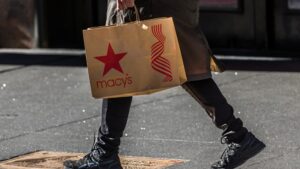February Retail Sales: A Mixed Bag with Implications for the Future
Welcome to Extreme Investor Network, where we dissect the latest economic trends and equip you with the insights necessary to navigate the complex financial landscape. Today, we’re analyzing the latest retail sales data from February, a report that offers both encouraging signs and significant cautionary notes.
Consumer Spending Shows Resilience
According to the Commerce Department’s latest release, retail sales increased by 0.2% in February. While this growth is indeed a positive development, it’s important to note that it fell short of the 0.6% increase anticipated by Dow Jones analysts. This statistic becomes even more crucial when you consider the downwardly revised decline of 1.2% reported for January. So, while we’re seeing an uptick, it’s not as strong as many had hoped.
When stripping away automobile sales—often subject to seasonal fluctuations—an increase of 0.3% was reported, exactly in line with forecasts. This analysis indicates that while consumers remain cautious, they are still willing to spend on certain categories.
Our experts at Extreme Investor Network suggest focusing on these nuanced readings of consumer behavior. The slight uptick in sales demonstrates resilience, particularly against the backdrop of a generally pessimistic economic sentiment fueled by inflationary concerns and fears of a potential slowdown.
The Inflation Factor and Its Impact
According to a previous report from the Labor Department, prices rose by 0.2% in February. This suggests that consumer spending has kept pace with inflation, a crucial point for investors and businesses alike. The underlying consumer sentiment appears to be one of cautious optimism, as highlighted by Robert Frick, corporate economist with Navy Federal Credit Union: "Not a great report, but one still in positive territory despite how pessimistic consumers are about the future."
This trend raises questions about how sustained these spending habits can be, especially as inflationary pressures persist. When consumers feel that their buying power is under threat, discretionary spending often takes a hit.
Boons and Banes in Retail Categories
Diving further into the breakdown of spending reveals both bright spots and trouble areas. Notably, online retailers saw a solid gain of 2.4%. The convenience and often competitive pricing of online shopping continue to drive consumer behavior, a trend that’s likely here to stay. Other sectors showing a positive trajectory include health and personal care, which grew 1.7%, and food and beverage outlets, which reported a 0.4% increase.
However, not all sectors fared so well. Bars and restaurants experienced a 1.5% decline, while gas stations were down 1% amidst falling petroleum prices. These mixed signals indicate varying levels of consumer confidence across different sectors of the economy—an important consideration for investors looking to make informed decisions.
Year-Over-Year Gains and Economic Concerns
On a year-over-year basis, retail sales have increased 3.1%, which outpaces the inflation rate of 2.8% according to the Consumer Price Index. While this is certainly encouraging, we must remain cautious, especially given the revised numbers for January, which painted a less favorable picture than initially reported.
The report arrives at a challenging time when economic growth is under scrutiny. With ongoing tariffs and international trade tensions influencing the market dynamics, concerns about inflation and consumer spending habits are intensifying. Elizabeth Renter, a senior economist at NerdWallet, underscores this sentiment, stating that uncertainties in economic policymaking complicate consumers’ ability to make informed spending decisions.
What Lies Ahead?
Looking ahead, indicators from the Atlanta Federal Reserve’s GDPNow tracker suggest potential negative growth in the first quarter. However, the positive reading in control retail sales could lead to upward revisions as new data emerges. Market participants will need to remain vigilant, weighing these mixed signals against broader economic indicators.
At Extreme Investor Network, we encourage our readers to stay informed and agile as they navigate these complexities. Understanding the underlying trends in consumer behavior can offer critical insights for making investment decisions and positioning in the current economic environment.
As we continue to track these developments, make sure to subscribe to our blog for expert analysis and strategies tailored for informed investors. Your financial future is too important to leave to chance—let us help you make sense of the numbers.

